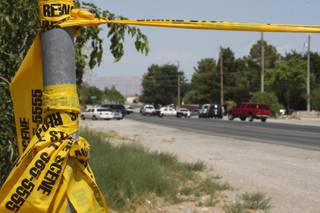Published Friday, Aug. 14, 2009 | 4:37 p.m.
Updated Friday, Aug. 14, 2009 | 6:41 p.m.
Officer-involved shooting
A Clark County coroner’s inquest jury today found the death of a man shot by a Metro Police officer justified.
John Paul Hambleton, 32, of Las Vegas, died July 1 from a perforating gunshot wound to the back.
Officer Jeremy Hendricks, 30, fired twice at the man after a quarter-mile chase involving multiple scuffles between the two men.
The shooting came seconds after Hambleton was able to get a Taser from the officer and use it against him, said Dean Raetz, a Metro homicide detective who investigated the incident.
Testimony during the inquest also included the two Metro detectives involved in the incident, four witnesses to parts of the chase and the medical examiner who performed the autopsy on Hambleton.
The jury of seven came to their conclusion after about six hours of testimony describing the events of the day.
Hendricks and his partner, Angie Christensen, went to the El Jen Convalescent Center, 5538 Duncan Drive, where Hambleton worked, to interview him about a sexual assault case.
The detectives had evidence that Hambleton had been in a sexual relationship with a now 16-year-old girl since she was 13.
Hambleton agreed to an interview in Hendricks’ car, was patted down by the detective to check for weapons and was advised of his Miranda rights, Hendricks testified.
After a conversation in the vehicle, Hambleton became agitated and requested a lawyer, at which time the interview ended and everyone left the car, the detectives both testified.
Once outside the car, Hambleton began acting strange, so Hendricks decided to place him under arrest, he said.
The detective said he believed he had enough evidence to convict Hambleton on nine felony counts.
Instead of submitting to the arrest, Hambleton began to run, the detectives testified. After a verbal warning, Hendricks fired his Taser at Hambleton, but the shock failed to stop him.
Hendricks continued to chase Hambleton around the block, with the two eventually covering a quarter mile in just a couple of minutes.
They ended up in front of a house at 5574 West Alexander Road, near the intersection with Helen Avenue.
Hendricks was able to grab Hambleton and pull him to the ground, using the direct stun feature of the Taser to temporarily disable him.
In the ensuing scuffle, Hambleton got the Taser away from Hendricks and used it to shock the detective.
“I was 100 percent sure I was getting Tased,” Hendricks said.
When the two got off the ground, they faced each other momentarily.
“He says, ‘Just (expletive) shoot me,’ “ Hendricks testified.
“My thought was not to just shoot him,” he said. “I’ve been told ‘shoot me’ by hundreds of people, and of course we don’t do that.”
After running another short distance, Hambleton turned to Hendricks to use the Taser against him again, Hendricks said.
“I knew this just turned into an attack on me.”
The detective said he was worried that if the Taser was used against him again, he would be immobilized and unable to keep his gun away from Hambleton, who had already tried to get it from the officer’s belt once during the scuffle.
“His actions caused me to have to use my firearm,” Hendricks said. “He left me no other options.”
Hendricks testified that from his investigation he knew Hambleton had previously threatened to commit suicide with a firearm and that he had been in the military and knew how to use weapons.
The detective fired twice, but only one shot hit Hambleton, entering through his back.
Hendricks testified that the two were facing when he pulled out his gun.
Raetz, the Metro homicide detective, testified that it is common for there to be a delay in a police officer’s reaction.
In the time it takes for an officer to pull the trigger, a person can turn 90 degrees, even if the officer’s finger is already on the trigger, Raetz said.
In the time it takes for an officer to get a gun out of a holster, aimed and fired, a person can turn 360 degrees, he said.
After the shooting, the coroner’s office initially identified Hambletons’ cause of death as a gunshot wound to the chest rather than to the back. The mistake, they said the following day, was due to “an administrative error.”


Join the Discussion:
Check this out for a full explanation of our conversion to the LiveFyre commenting system and instructions on how to sign up for an account.
Full comments policy